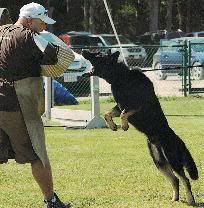I had similar problems with my GSD. He acted aggressively to other dogs and strangers, especially if they were riding bikes, skateboards or jogging.
Here's a version of a PM (modified to your specific situation) I sent to another member about problems with walks:
I wholeheartedly believe in the prong collar for correcting problems with walks. I've seen it work over and over. When people tell me it doesn't work and then I work with them, it turns out that it's been because they weren't using it properly.
I wouldn't say there isn't a single dog that's resistant to prong corrections, but I think that's the exception to the rule. I personally have never had an exception to that rule.
Here's a prong checklist (made up of problems I've seen people have with prongs) for you to make sure you've got the right idea:
*Is it very high on the neck? It should be right behind the skull.
*Is it tight enough? This is one time when you want the collar to be tight. You shouldn't be able to rotate around the dog's head. Of course you don't want it so tight that it constricts his breathing, but remember the prong doesn't tighten like a noose the way a choke does, so you don't want spare room.
*The rings should be on the right side of the dog's neck, not at the back of his head. Remember, you want your dog walking next to you, not in front of you.
*The prongs should be making reasonable contact with the skin. If it's on as tight as it should be, then you shouldn't be able to rotate it, but you should wiggle it back and forth a little to make sure that the prongs have worked through the thick neck fur.
*When working your dog with walking issues, always always always begin in an isolated area. Walk around your yard or something. This is highly important. A distracted dog can't learn and a distracted trainer can't train. Set it up so you have the most likelihood of success...it teaches the dog how he is supposed to walk with you and it gives you the freedom to completely focus on your dog instead of worrying about what's around the next corner. You need to be confident before you can expect your dog to be.
Do this a lot before you gradually increase distraction. And that means, do it with one person around, then work to two, then to doing it around cars, then in a crowd, then around another dog, then around lots of dogs and people and cars and so on.
Depending on the dog, it can be a long process, but it's the only way it will work. Otherwise you're asking your dog to do the equivilant of asking you to recite the alphabet backward, skipping every four letters, in a room full of naked swimsuit models.
*The prong correction should be significant; if he yelps, that's okay. You shouldn't worry about a surprised, single yelp (not screaming though!). It may sound bad to you at first, but you need his attention and you need to make it clear to him what the correction is.
*Many people tug on the prong, or lift, instead of a super quick and hard pop.
*The leash should be hooked on the live ring, not the dead ring if your dog is ignoring the corrections on the dead ring.
*The leash should be slack, except for when you give corrections. Otherwise they get used to pressure from the prong and that will counteract your efforts. They should learn that ANY pressure is going to mean a good, startling pop.
*Pick out the area you allow your dog to go from you, in any direction, and say "heel" and then correct the instant your dog steps out of it. At first, this will mean a lot of corrections, but he'll get it. Don't pop and say heel at the same time or "heel" will come to have the same negative connotations as NO! Use another word or sound when you correct. Heel is a command not a punishment.
*ALWAYS ALWAYS ALWAYS remember to praise and reward when the dog is in the proper space. Positive reinforcement is often overlooked and necessary for a good training session. If it's all corrections, your dog will hate the work, and you! It also has practical applications as well: If you tell your dog what NOT to do and also what is RIGHT, you eliminate a lot of grey area for your dog and it will speed up training.
*Always use five star treats if your dog is food motivated...something the dog adores that he ONLY gets during training. I used roast beef on my GSD because of the smell and the small pieces you can use. Others use small pieces of hot dog. My Corgi will only work for American cheese. :-)
*Burn some energy off of your dog before you start to train. He shouldn't be exhausted, but he shouldn't be spastic, either. Play fetch or something to burn some nervous energy, take him swimming (if you can) or just jog around the yard with him.
A hard dog is a good dog for a novice trainer. That means you can make mistakes without your dog killing you. But to be honest, most people UNDER correct. It's natural. You love your dog and you're afraid of hurting him or your bond with him. But a good strong correction given without malice or anger is totally natural to the dog, especially when coupled with the right kind of praise and reward for correct behavior.
Hope this helps.

Carbon
 Previous Topic
Previous Topic Index
Index Next Topic
Next Topic











 Top
Top



.jpg)

